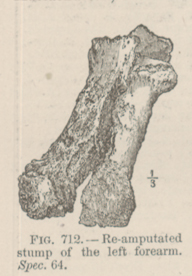Title: Neill, I.
Source text: The Medical and Surgical History of the War of the Rebellion. (1861-65.), Part 2, Volume 2 (Washington, DC: Government Printing Office, 1876), 978.
Civil War Washington ID: med.d2e31361
TEI/XML: med.d2e31361.xml
CASE 1926.—Private I. Neill, Co. D, 16th Mississippi, aged 38 years, was wounded at the Weldon Railroad, August 21, 1864. From a field hospital he was admitted to the Depot Hospital, Fifth Corps, City Point, where Surgeon W. L. Faxon, 32d Massachusetts, recorded: "Gunshot wound of arm; amputation." Assistant Surgeon J. C. McKee, U. S. A., reported the man's admission to Lincoln Hospital, Washington, August 24th, and the following history: "Gunshot fracture of left forearm, lower third, followed by amputation at the middle third. The operation was performed by Assistant Surgeon J.T. Duffield, 7th Indiana, on the day after the injury, by the circular method. The stump continued in a very unhealthy condition until April 12, 1865, when it was re-amputated by Acting Assistant Surgeon N.A. Robbins, by a circular operation at the lower third of the humerus. (Compare CASE 26, TABLE LXXXVII, p. 788.) On the evening of the following day the patient received a severe shock on the stump by one of the attendants in the ward falling with his whole weight upon the injured member. On the next morning he commenced to fail rapidly, and the same day he was taken with a severe chill with diagnostic signs of pyæmia. Quinine exhibited in large doses failed to produce the desired effect, and the chills continued. A large abscess formed over the external aspect of the knee joint, containing dark and fetid pus. The general treatment consisted of water dressings and tonics, with a solution of bisulphate of soda, half an ounce to six ounces of water, given in doses of two teaspoonfuls every three hours, after the development of pyæmia. The patient died April 17, 1865." The specimen, represented in the annexed cut (FIG. 712), consists of the upper thirds of the bones of the forearm, and was contributed by Acting Assistant Surgeon J. P. Arthur. "Each bone is enlarged, but carious, and superficial diseased action occupies nearly the whole of the shaft of the ulna."
